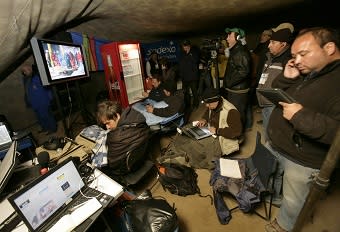 The Upshot
The UpshotMine rescue turns into worldwide media spectacle

The Chilean miners now reaching the surface are quickly finding out just how outnumbered they are by journalists on the ground: roughly 60 to 1.
NBC's Kerry Sanders, one of 2,000 members of the media staked out in Chile's Atacama Desert , said Wednesday morning that the press pack includes reporters from Finland, Yemen, Russia — even North Korea. "The whole world is watching all of this unfold," Sanders said during an on-air broadcast. "And in this 24-hour cycle, whoever's waking up, in whatever part of the world, they're watching."
It's estimated that more than 1 billion people watched the first miner, Florencio Avalos, emerge from the ground at 12:04 a.m. Wednesday local time (11:04 p.m. Tuesday ET) — a historic moment aired by television networks around the world. And for viewers riveted by the story, there are still hours (or perhaps days) of extensive coverage to come -- whether live from the mine site or through interviews with the miners who are still trapped underground.
[Read more: Trapped miners had to move 3,000 tons of rock]
Knowing a good opportunity for exposure when he sees it, Chilean President Sebastian Pinera has reversed his earlier position on barring state-run Chilean television from broadcasting the rescue. Pinera himself is also on hand, greeting each new freed miner with a bear hug. The high-profile spectacle is an undeniable boon to his administration, which has been dogged by criticism of allegedly sluggish and inadequate responses to the earthquake and tsunami that devastated the South American country shortly after Pinera came into power.
Click image to see photos of the rescue efforts
AP/Hugo Infante, Chilean government
Unlike, say, a space shuttle launch, the drama in Chile isn't over quickly. It takes about an hour to bring each Chilean miner -- of whom there are 33 -- to the surface. So the compelling human drama that began to playing out Tuesday night will continue as all-out media spectacle Wednesday, with networks around the world cutting in with live shots of each of the miners emerging after 70 days underground.
Three major U.S. cable news networks — Fox News, MSNBC and CNN — cut into Tuesday's prime-time shows to bring live coverage of the rescue. New York Times reporter Brian Stelter noted that "wall-to-wall coverage" continued on the cable networks through the night, with international networks such as the BBC, CNN International and Al Jazeera English also broadcasting "live for hours at a time."
[Related: How the miners made two days of food last for weeks]
But Stelter added that the gripping coverage wouldn't have come together without the assistance of Chilean state television, which captured "most of the pictures of the rescued miners and their family members." Bill Weir, co-anchor of ABC's "Nightline," thanked Chilean TV on the air and said that "there are award-show or Super Bowl producers or directors who are probably watching this with envy."

Miners have not only been preparing for the brightness of the sun, but also for the flashes of cameras.
The Toronto Sun reports that the miners have received media training in recent days, with a former journalist instructing them on practical issues such as how to deflect unwanted questions. For instance, the miners are planning not to speak on certain matters, such as an alleged "love triangle" that tabloid reporters seized on during the ordeal.
But even media training can't completely prepare the miners for the crush of sharp-elbowed journalists jostling to get a photo or quote before the rescued workers are flown to a nearby hospital.
And there are already reports of "media mayhem" on the ground.
"The joy of family members of the first miner to be rescued in Chile on Wednesday turned suddenly to horror when hundreds of journalists trampled their humble tent in a mad rush to speak to them," reported AFP.
[Banned: What was approved, censored for trapped miners]
It's not surprising that pushing and shoving took place at the historic moment the first miner was rescued, given that journalists have been staking out positions for days.
The Guardian reported Tuesday how journalists were fighting over bathrooms or the best spots to cover the ensuing action. For instance, the British paper reported that a Japanese photographer got into a fight with U.S. producer over a boulder that would be "perfect for a satellite dish." It was a much-coveted spot because "all the other spots in this corner of Camp Hope were already colonized by a tangled splurge of cables and antennae."
(Photo of a camp screen showing a televised image of Avalos' rescue near Copiapo, Chile: AP/ Natacha Pisarenko. Photo of journalists before his rescue: AP/Jorge Saenz.)
Other popular stories on Yahoo!:
• Surprising family relationship between Palin, Obama
• New supercar is world's fastest
• Walmart's rollback strategy backfires


